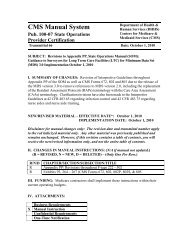2003 Louisiana Vital Statistics Report - Louisiana Department of ...
2003 Louisiana Vital Statistics Report - Louisiana Department of ...
2003 Louisiana Vital Statistics Report - Louisiana Department of ...
Create successful ePaper yourself
Turn your PDF publications into a flip-book with our unique Google optimized e-Paper software.
TECHNICAL NOTES <strong>2003</strong> LOUISIANA VITAL STATISTICS REPORT<br />
DEATH DATA<br />
Place <strong>of</strong> Residence<br />
Place <strong>of</strong> Residence is defined as the residence <strong>of</strong> the deceased for a death and as the residence <strong>of</strong> the mother for a stillbirth.<br />
Cause <strong>of</strong> Death Coding<br />
Classification System: World Health Organization regulations specify that member nations classify cause <strong>of</strong> death in accordance<br />
with the current revision <strong>of</strong> the International Statistical Classification <strong>of</strong> Diseases, Injuries, and Causes <strong>of</strong> Death (ICD). The ICD<br />
has been revised approximately every ten years since 1900. The current revision, ICD-10, was implemented beginning with<br />
deaths occurring on January 1, 1999. For more information on the tenth revision, please visit the Centers for Disease Control<br />
and Prevention website at: http://www.cdc.gov/nchs/about/major/dvs/icd10des.htm.<br />
Underlying Causes: Prior to 1949, under the first five revisions <strong>of</strong> the International Classification, causes <strong>of</strong> death were coded<br />
based on priority tables for multiple causes as set forth in The Manual for Joint Causes <strong>of</strong> Death. Under the sixth through the<br />
tenth revisions, the cause <strong>of</strong> death coded for tabulating death data is the "underlying cause" as determined from information<br />
provided on the death certificate by the attending physician or coroner. Currently, when more than one cause <strong>of</strong> death exists,<br />
the causes are ordered according to the Automated Classification <strong>of</strong> Medical Entities (ACME) system. ACME is a computerized<br />
program that evaluates both the ICD-10 code characteristics and the components <strong>of</strong> the death history recorded on the certificate<br />
to determine the primary, or “underlying,” cause <strong>of</strong> death. The "underlying cause" may be defined as (a) the disease <strong>of</strong> injury<br />
that initiated the train <strong>of</strong> morbid events leading directly to death or (b) the circumstances, accident, or violence that produced the<br />
fatal injury.<br />
Comparability <strong>of</strong> <strong>Statistics</strong> from ICD-9 to ICD-10: The decennial revisions <strong>of</strong> the International Classification <strong>of</strong> Diseases (ICD)<br />
have led to repeated breaks in the comparability <strong>of</strong> cause-<strong>of</strong>-death data. The introduction <strong>of</strong> the present concepts <strong>of</strong><br />
classification in the sixth revision seriously affected the interpretation <strong>of</strong> mortality trends before and after 1949. Comparability<br />
ratios were subsequently computed by the United States to assist in the analysis <strong>of</strong> mortality trends by providing a measure <strong>of</strong><br />
the degree <strong>of</strong> discontinuity. Following the recommendations <strong>of</strong> the International Conference for the Sixth Revision <strong>of</strong> the ICD,<br />
the United States used a dual coding method for constructing these comparability ratios after the introduction <strong>of</strong> each <strong>of</strong> the last<br />
five revisions, including the current ICD-10.<br />
For a more detailed description <strong>of</strong> the role played by comparability ratios in interpreting the differences between ICD-9 and ICD-<br />
10, please see Comparability <strong>of</strong> Cause <strong>of</strong> Death Between ICD-9 and ICD-10: Preliminary Estimates, Vol. 49 No. 2 [DHHS<br />
Publication No. (PHS) 2001-1120 1-0355 (5/2001)], National <strong>Vital</strong> <strong>Statistics</strong> <strong>Report</strong>s, National Center for Health <strong>Statistics</strong>,<br />
Centers for Disease Control and Prevention, May 18, 2001. This publication can be downloaded from the National Center for<br />
Health <strong>Statistics</strong> website at: http://www.cdc.gov/nchs/data/nvsr/nvsr49/nvsr49_02.pdf.<br />
Cause <strong>of</strong> Death Ranking: Beginning with ICD-10 in 1999, cause <strong>of</strong> death rankings are based on the "List <strong>of</strong> 113 Selected<br />
Causes <strong>of</strong> Death" developed by the National Center for Health <strong>Statistics</strong>. This list was adapted from a basic list recommended<br />
by the World Health Organization for use with the Tenth Revision <strong>of</strong> the ICD. The categories "Major Cardiovascular Diseases"<br />
and “Symptoms, signs and abnormal clinical and laboratory findings, not elsewhere classified" are not ranked. In addition,<br />
categories that begin with the words "Other" or “All Other" are not ranked. To determine the leading causes <strong>of</strong> death, the<br />
remaining categories are ranked according to the number <strong>of</strong> deaths that occur in the calendar year. When a category that<br />
Page 158 <strong>Louisiana</strong> Office <strong>of</strong> Public Health, State Center for Health <strong>Statistics</strong>
















